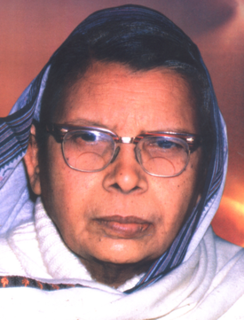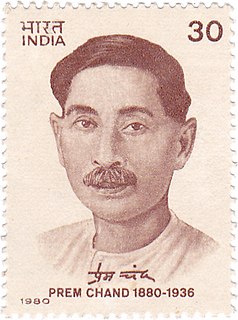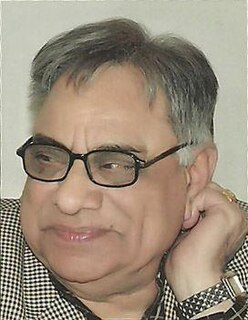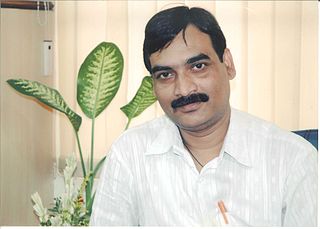
Hindi, or more precisely Modern Standard Hindi, is an Indo-Aryan language spoken chiefly in the Hindi Belt region encompassing parts of northern, central, eastern and western India. Hindi has been described as a standardised and Sanskritised register of the Hindustani language, which itself is based primarily on the Khariboli dialect of Delhi and neighbouring areas of Northern India. Hindi, written in the Devanagari script, is one of the two official languages of the Government of India, along with English. It is an official language in 9 States and 3 Union Territories and an additional official language in 3 other states. Hindi is also one of the 22 scheduled languages of the Republic of India.

Urdu is an Indo-Aryan language spoken chiefly in South Asia. It is the national language and lingua franca of Pakistan. In India, Urdu is an Eighth Schedule language whose status, function, and cultural heritage is recognized by the Constitution of India; it also has an official status in several Indian states. In Nepal, Urdu is a registered regional dialect.

Hindustani is the lingua franca of Northern India and Pakistan; in linguistics and some other contexts, it is also known as Hindi–Urdu,.
Hindi literature includes literature in the various Hindi language which have writing systems. It is broadly classified into four prominent forms (styles) based on the date of production. They are:

Hindustan (Persian: هندوستان, pronunciation , along with its shortened form Hind, is the Persian name for India, broadly the Indian subcontinent, which later became used by its inhabitants in Hindi–Urdu. Other toponyms of the subcontinent include Jambudvipa, Bharata, and India. After the Partition of India, it continues to be used as a historic name for the Republic of India.

Mahadevi Varma was an Indian Hindi-language poet, essayist, sketch story writer and an eminent personality of Hindi literature. She is considered one of the four major pillars of the Chhayawadi era in Hindi literature. She has been also addressed as the Modern Meera. Poet Nirala had once called her "Saraswati in the vast temple of Hindi Literature". Varma had witnessed India both before and after independence. She was one of those poets who worked for the wider society of India. Not only her poetry but also her social upliftment work and welfare development among women were also depicted deeply in her writings. These largely influenced not only the readers but also the critics especially through her novel Deepshikha.

Dhanpat Rai Srivastava, better known by his pen name Premchand, was an Indian writer famous for his modern Hindustani literature. Premchand was a pioneer of Hindi and Urdu social fiction. He was one of the first authors to write about caste hierarchies and the plights of women and labourers prevalent in the society of late 1880s. He is one of the most celebrated writers of the Indian subcontinent, and is regarded as one of the foremost Hindi writers of the early twentieth century. His works include Godaan, Karmabhoomi, Gaban, Mansarovar, "Idgah". He published his first collection of five short stories in 1907 in a book called Soz-e-Watan.
Urdu literature is literature in the Urdu language. While it tends to be dominated by poetry, especially the verse forms of the ghazal غزل and nazm نظم, it has expanded into other styles of writing, including that of the short story, or afsana افسانہ. Urdu literature is mostly popular in Pakistan, where Urdu is the national language and India, where it is a recognized language. It is also widely understood in Afghanistan and has moderate amount of popularity in Bangladesh.

Awadhi, also known as Oudhi, is an Eastern Hindi language of the Indo-Aryan branch spoken in northern India. It is primarily spoken in the Awadh region of present-day Uttar Pradesh, India. The name Awadh is connected to Ayodhya, the ancient city, which is regarded as the homeland of the Hindu god Rama. It was, along with Braj Bhasha, used widely as a literary vehicle before being displaced by Hindustani in the 19th century.

Hindustan Times is an Indian English-language daily newspaper founded in 1924 by Sunder Singh Lyallpuri, founder-father of the Akali movement and the Shiromani Akali Dal in the Punjab Province. It played integral roles in the Indian independence movement as a nationalist daily. The newspaper is owned by Shobhana Bhartia. It is the flagship publication of HT Media, an entity controlled by the KK Birla family.
HT Media is an Indian mass media company based in Delhi, India. It has holdings in print, electronic and digital media.

Uday Prakash is a Hindi poet, scholar, journalist, translator and short story writer from India. He has worked as administrator, editor, researcher, and TV director. He writes for major dailies and periodicals as a freelancer. He has also received several awards for his collection of short stories, Mohan Das. Nayantara Sahgal returns her Sahitya Akademi award on October 6. Sets off a storm of protests.

Kewal Dheer is an Indian writer and author.

Ravindra Prabhat is a Hindi novelist, journalist, poet, and short story writer from India. He has worked as an editor and screen play writer. Some of his works have been translated into other languages and published in various literary magazines and anthologies.

Meghna Pant is an Indian author, journalist and speaker. She has won a variety of awards for her contribution to literature, gender issues and journalism. In 2012, she won the Muse India National Literary Awards Young Writer Award for her debut novel One-and-a-Half Wife. Her collection of short stories, Happy Birthday and Other Stories was long-listed for the Frank O’Connor International Award.

Madhur Kapila was an Indian novelist, journalist, art critic and a reviewer of Hindi literature. Some of her published works included Bhatke Raahi, Satwan Swar and Saamne ka Aasman. She was a recipient of the Chandigarh Sahitya Akademi Award for lifetime contributions to literature and the Cultural Representative Award from the Punjab Sangeet Natak Akademi.
Saraswati was the first Hindi monthly magazine of India. Founded in 1900, by Chintamani Ghosh, the proprietor of Indian Press, in Allahabad, its success under the editorship of littérateur Mahavir Prasad Dwivedi (1903–1920), led to flourishing of modern Hindi prose and poetry especially in Khariboli dialect. It became the most influential periodical in the Hindi literature during the first two decades of the 20th century.
The Media in Gujarati language started with publication of Bombay Samachar in 1822. Initially the newspapers published business news and they were owned by Parsi people based in Bombay. Later Gujarati newspapers started published from other parts of Gujarat. Several periodicals devoted to social reforms were published in the second half of the 19th century. After arrival of Mahatma Gandhi, the Indian independence movement peaked and it resulted in proliferation of Gujarati media. Following independence, the media was chiefly focused on political news. After bifurcation of Bombay state, the area of service changed. Later there was an increase in readership due to growth of literacy and the media houses expanded its readership by publishing more number of editions. Later these media houses ventured into digital media also. The radio and television media expanded after 1990.

Malti Joshi is an Indian novelist, essayist, and writer, who writes primarily in the Hindi and Marathi languages. She was awarded the Padma Shri, one of India's highest civilian honours, in 2018.
Iti Rani Samanta is an Indian columnist, journalist and film producer. She won the Odisha State Film Awards in 2014 for Best Story Writer. She is also the editor of the monthly family magazine The Kadambini and the children’s magazine The Kunikatha.















